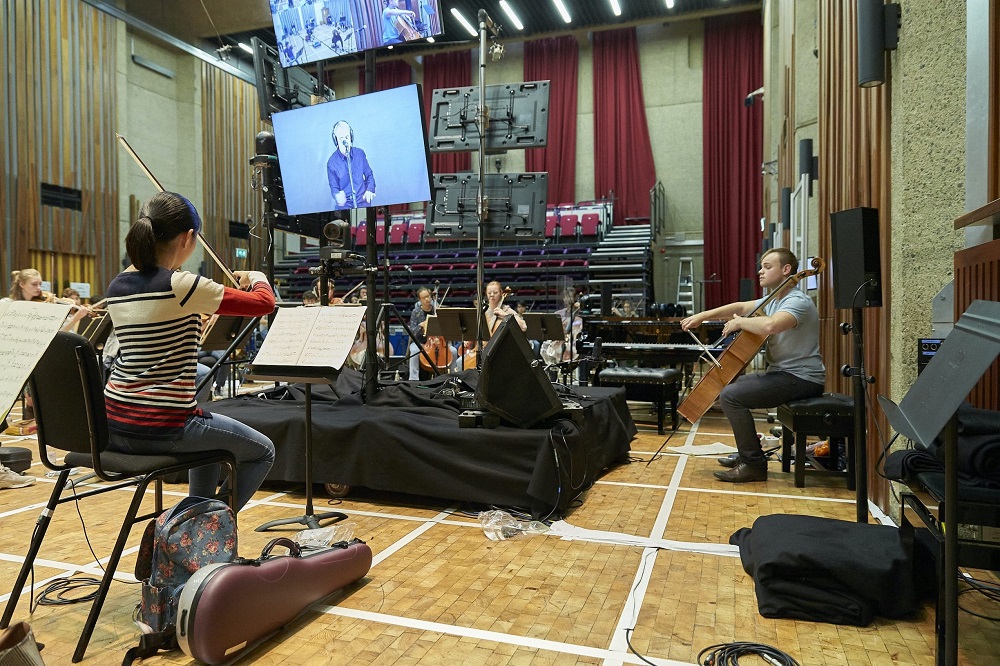A senior lecturer can hold class anywhere on a college campus while, simultaneously, sending the live content anywhere in the world, all in real time. A band director can host practice without having all of the wind ensemble and brass performers in the same room — or even in the same building! Musicians can play along from their living rooms, following each of the conductor’s hand movements. Applications for real-time collaboration are truly endless. However, for any of this to happen, education institutions need a strong network infrastructure to support it.
Lessons From the Pandemic
The COVID-19 pandemic changed the way that many learning institutions look at education. For example, at Vanderbilt University, an education institution where the majority of students live on campus, school leaders proved during the pandemic that it was possible to keep learning going remotely.
“[We] can bring in guest speakers — subject-matter experts from all over the world — into an equipped classroom where, previously, that wasn’t possible because we hadn’t embraced that remote model before,” says BC Hatchett, associate director, classroom technology, at Vanderbilt University. Hatchett is also co-founder and board member emeritus of the Higher Education Technology Managers Alliance (HETMA).
Today’s technology managers want sustainable, supportable and scalable solutions. “We don’t want one-offs,” Hatchett declares. “We don’t want something that’s going to be a Band-Aid. Whenever we make a technology investment, we want to make sure that we’re getting our money’s worth out of it.” Continuing the thought, he adds, “We want to make sure that we’re still able to use it and modify it and upkeep it three to five years down the road.”
What’s more, higher-ed technology managers aren’t looking for the big, podium-tethered boxes of yesteryear, which were only capable of doing one or two things. When room peripherals like microphones and speakers are moved onto the network, it opens more possibilities for quick and easy room configuration. Thus, higher-education institutions have begun to realize the potential associated with AV-over-IP systems and leveraging network-based architecture. Technology managers like Hatchett plan to do as much as possible of that going forward.
AVoIP Campus
Having an AVoIP campus makes things a lot more user friendly, Hatchett confirms. “The more items that are on the network — especially with some of the monitoring, metrics and software we use — we can tell in real time when something is not working.” That empowers either the technology manager or the integrator to reboot the system or diagnose the issue remotely, without necessarily having to send somebody to the site.
Although many academic institutions are embracing AVoIP, we must acknowledge that, yes, a learning curve still exists from a traditional AV standpoint. “It’s not Cresnet or HDBaseT or whatever the traditional connections are,” Hatchett concedes. “It is a true network delivery method. You’ve got to retool a bit. You’ve got to have some network knowledge, networking skills or at least a good relationship with your campus network operations team.” He also acknowledges the fact that, if you’re relying on the network, you’re necessarily losing a bit of control. As Hatchett puts it, “You have certain rules and regulations that you have to follow that the network operations team requires.” But Hatchett sees it as an opportunity to leverage a partnership with the network operations team, as opposed to having to branch into something altogether new.
Cost Factor
Cost is another factor that can inhibit many education institutions that, otherwise, would implement AVoIP. “The capital cost for analog equipment will always be less than IP,” Bob Ehlers, vice president of business planning, Audinate, acknowledges. “The operating cost and the total cost of ownership — that’s [what’s] changing things.” He elaborates further, saying, “With IP-based systems, there’s remote supportability, diagnostics, data, usage, feedback about what’s going on with all the equipment in the room, and auto recovering when there’s a failure. The operating cost [benefits] far supersede the capital expenditure.”
With AVoIP systems, staff members can easily reconfigure rooms to suit a professor’s liking. One professor might have their back to a projection screen; another might talk in front of a whiteboard; another might stand at a podium with a mic; another might like to use a lapel mic; and yet another might prefer to use the audio from their laptop. Technology teams must accommodate all those things quickly, especially when staff only have maybe five or 10 minutes in between classes. “That would not be possible with analog,” Ehlers states.
“We’re seeing more classroom reconfiguration [and] interconnectivity,” Ehlers adds. “Classes may span different rooms within the same campus; or different rooms on different campuses; or hybrid, where the students are working remote.”
A Good Network Integrator
For integrators installing these systems, Ehlers offers a word of advice: Be a good network integrator first. “Then,” he continues, “you have to be an audio engineer and video engineer. And then, you can be a Dante expert. It all boils down to technical skill and knowledge.” Historically, that range of core competencies has lived in three different people, each with a specific skill set. That’s no longer the case, though.
“The network engineer has to understand what the AV engineer is doing and why,” Ehlers opines. “For example, why they need to install a multicast and the secure way to do it.” Broadly, he encourages integrators to build out their skill sets and not underestimate the complexity of AVoIP deployments.
Ultimately, these next-generation systems, if deployed properly, make things simpler for the client. “If my AV system is like my cell phone, with 27 apps for all sorts of different things, that’s a failure for the industry,” Ehlers declares. “Somebody needs to be able to run into a room, with no instructions, and be able to figure it out.” Integrators must not forget to deliver that simplicity for both the end user and those who manage and maintain those systems.




